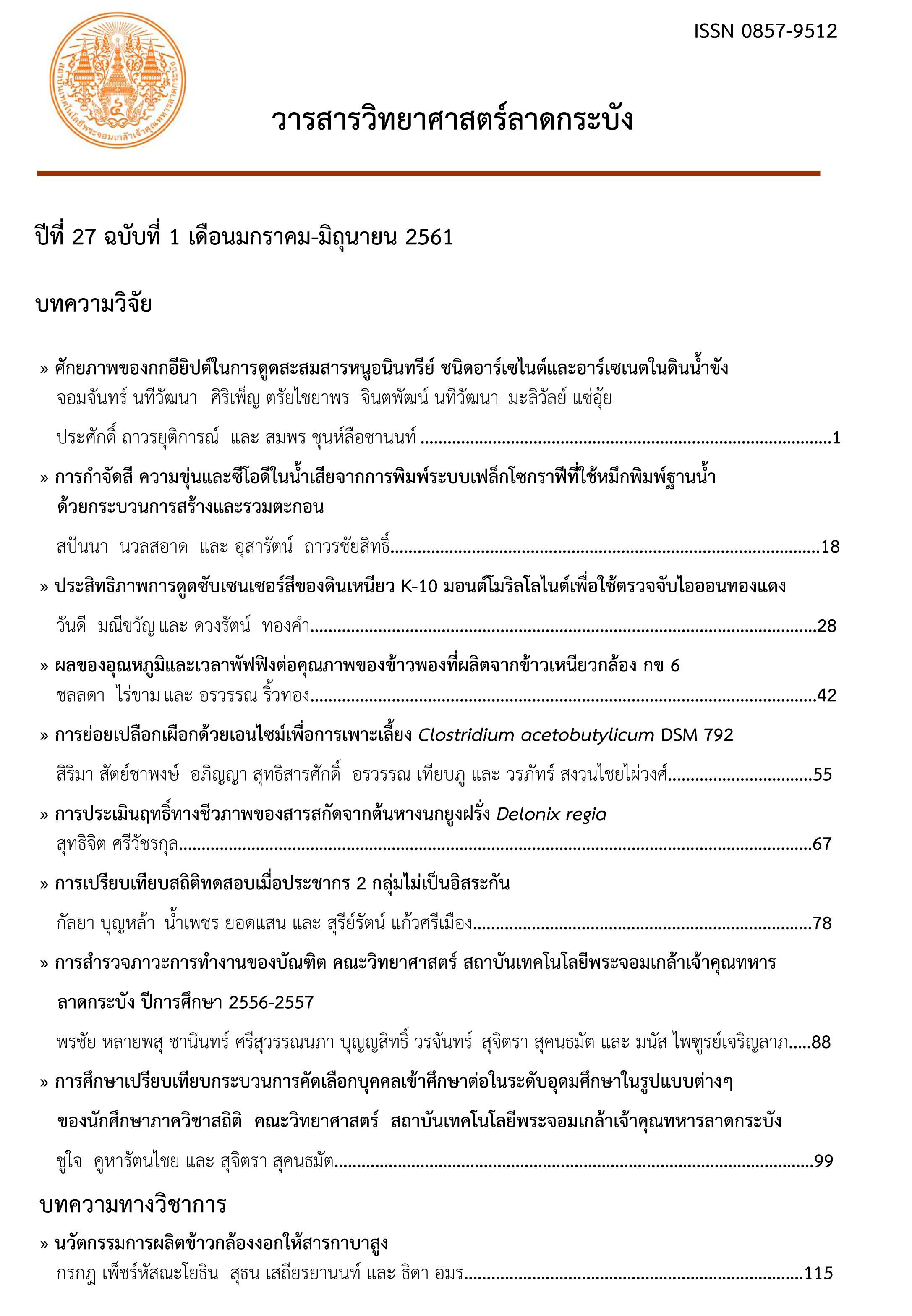ศักยภาพของกกอียิปต์ในการดูดสะสมสารหนูอนินทรีย์ ชนิดอาร์เซไนต์และอาร์เซเนตในดินน้ำขัง
Main Article Content
Abstract
งานวิจัยนี้มีวัตถุประสงค์เพื่อศึกษาคุณสมบัติของการเป็นพืชบำบัดของกกอียิปต์ในการดูดสะสมปริมาณสารหนูทั้งหมดในดินที่ปนเปื้อนสารหนูอนินทรีย์ในรูป As(III) และ As(V) รูปแบบการทดลองแบบแฟคทอเรียล 3 × 4 ในแบบแผนการทดลองแบบสุ่มสมบูรณ์ ประกอบด้วย 2 ปัจจัยคือ ชนิดของสารหนูในดินได้แก่ As(III) และ As(V) รวมทั้งชุดควบคุม จำนวนวันที่เพาะปลูก 4 ระยะเวลาได้แก่ 15, 30, 45 และ 60 วัน ผลการศึกษาพบว่า เมื่อวิเคราะห์ความแปรปรวน (Two way ANOVA) ปัจจัยที่มีความแตกต่างอย่างมีนัยสำคัญ (p-value = 0.000) ของน้ำหนักแห้งที่ลดลงได้แก่ ชนิดของสารหนูในดิน โดยเมื่อเปรียบเทียบค่าเฉลี่ยในแต่ละกลุ่ม โดยวิธีของดันเนตต์พบว่า พืชที่ปลูกในดินที่ใส่ As(III) มีเปอร์เซ็นต์การลดลงของน้ำหนักแห้งมากกว่า As(V) ปัจจัยที่มีผลต่อการสะสมปริมาณสารหนูทั้งหมดในกกอียิปต์ทั้งต้นอย่างมีนัยสำคัญ (p-value = 0.000) ได้แก่ ชนิดของสารหนูในดิน และจำนวนวันที่เพาะปลูก โดยเมื่อเปรียบเทียบค่าเฉลี่ยพบว่า กกอียิปต์มีการสะสมปริมาณสารหนูทั้งหมดในดินที่ใส่ As(V) มากกว่า As(III) เมื่อเรียงลำดับค่าเฉลี่ยการสะสมปริมาณสารหนูทั้งหมดตามจำนวนวันที่เพาะปลูกพบว่า 30 > 15 > 45 > 60 และทั้ง 2 ปัจจัยที่มีอิทธิพลต่อกันอย่างมีนัยสำคัญ (p-value = 0.000) สำหรับปัจจัยที่มีผลต่อการ
* ที่อยู่ติดต่อ โทรศัพท์ 084-177-3194 Email address: [email protected]
สะสมปริมาณสารหนูทั้งหมดของอวัยวะส่วนต่างๆ ของกกอียิปต์อย่างมีนัยสำคัญ (p-value = 0.000)
รูปแบบการทดลองแฟคทอเรีย 3 × 4 × 4 ในแบบแผน การทดลองแบบสุ่มสมบูรณ์ จากการวิเคราะห์
ความแปรปรวน (Three way ANOVA) ได้แก่ ชนิดของสารหนูในดิน จำนวนวันที่เพาะปลูก และอวัยวะส่วนต่างๆ ของกกอียิปต์ โดยเมื่อเปรียบเทียบค่าเฉลี่ยพบว่า As(V) > As(III) > ชุดควบคุม, 30 > 15 > 45 > 60 และราก > ใบ > ลำต้นใต้ดิน > ลำต้น อีกทั้งปัจจัยที่มีอิทธิพลร่วมกันอย่างมีนัยสำคัญ 2 ปัจจัย
(p-value = 0.000) ได้แก่ ชนิดของสารหนูในดิน * จำนวนวันที่เพาะปลูก, ชนิดของสารหนูในดิน * อวัยวะส่วนต่างๆ ของกกอียิปต์ และจำนวนวันที่เพาะปลูก * อวัยวะส่วนต่างๆ ของกกอียิปต์ รวมทั้งปัจจัยทั้งสามมีอิทธิพลร่วมกันอย่างมีนัยสำคัญ (p-value = 0.000) ความเข้มข้นทางชีวภาพของกกอียิปต์ในดินที่ใส่ As(V) และ As(III) มีค่าสูงสุดในวันที่ 30 มีค่าเท่ากับ 0.9851 และ 0.7885 และค่าการเคลื่อนย้ายสารหนูขึ้นสู่ส่วนเหนือดินพบว่า ดินที่ใส่ As(III) มีค่าเพิ่มขึ้นอย่างต่อเนื่องตลอดการทดลองตั้งแต่ 0.78 – 2.54
ขณะที่ดินที่ใส่ As(V) มีค่าสูงในช่วงแรกแล้วค่อยๆ ลดลงโดยค่าอยู่ระหว่าง 1.57 – 2.54
คำสำคัญ : อาร์เซเนต สารหนู อาร์เซไนต์ กกอียิปต์ ดินน้ำขัง
The purpose of this research was to study the properties of Cyperus papyrus (L.) to total arsenic accumulation in arsenic contaminated submerged soil as arsenite As(III) and arsenate As (V) forms. The experimental design was 3 × 4 factorial in the CRD plan consisted of two factors including arsenic speciation in submerged soil: As (III), As (V) and control group, and growing periods: 15, 30, 45 and 60 days. As a result, two way ANOVA analysis was used to determine the significant factor of % dry weight decrease (p-value = 0.000) was arsenic speciation. The multiple comparison of mean in each group by Dunnett’s T3 method showed that C. papyrus in As (III) treated soils had a lower percentage of dry weight than As (V) treated soil. The factors significantly affecting total arsenic accumulation in C. papyrus (p-value = 0.000) were arsenic speciation and growing period. The multiple comparison found that C. papyrus accumulated total arsenic from As (V) treated soil greater than As(III) treated soil and growing periods were calculated as 30 > 15 > 45 > 60 as well as both 2 factors significantly influenced each other (p-value = 0.000). The significant factors affected the total arsenic accumulation of various organs of C. papyrus (p-value = 0.000) by 3 × 4 × 4 factorial experiment in the CRD plan (Three way ANOVA) including arsenic speciation, growing period, and various organs of C. papyrus. The multiple means comparison of factors found that As (V) > As (III) > Control group, 30 > 15 > 45 > 60 days, and root > leaf > rhizome > culm. Two factors had significant influence each other (p-value = 0.000) consisted of arsenic speciation * growing period, arsenic speciation * various organs C. papyrus, and growing period * various organs of C. papyrus, whereas these three factors had co-influence significantly (p-value = 0.000). Bioconcentrations of C. papyrus in As (V) and As (III) contaminated soil were the highest at 30 days at 0.9851 and 0.7885. Arsenic accumulation translocation factor found that C. papyrus in As(III) treated soil increased continuously throughout the experiment from 0.78 to 2.54, whereas As (V) treated soil was high value in the first stage and then gradually decreased between 1.57 - 2.54.
Keywords: Arsenate, Arsenic, Arsenite, Cyperus papyrus (L.), Submerged soil
